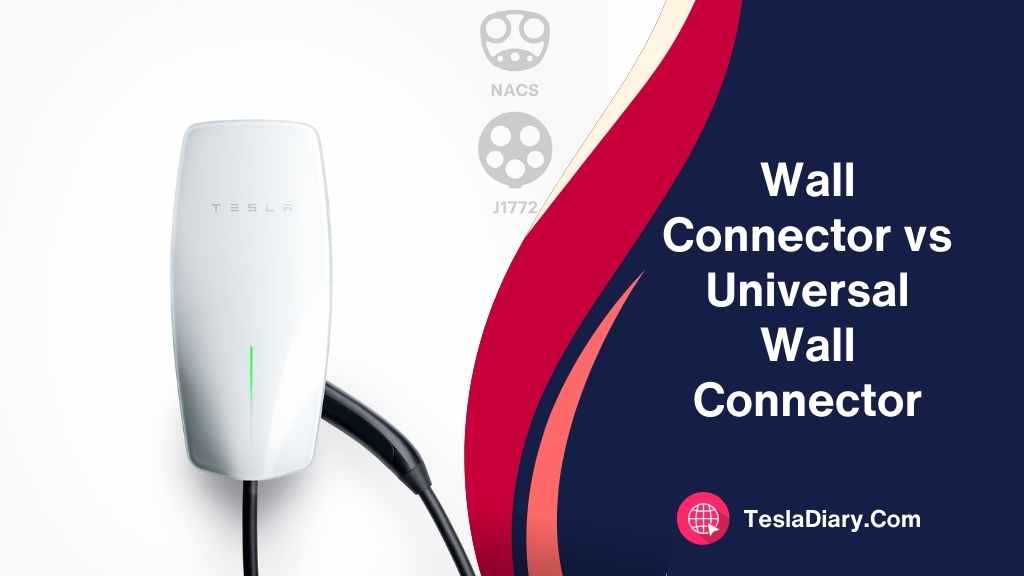As the electric vehicle (EV) market continues to expand, the need for efficient and versatile charging solutions has become paramount.
Tesla, a frontrunner in the EV industry, offers two primary home charging solutions: the Wall Connector and the Universal Wall Connector.
While both are designed to provide optimal charging for Tesla vehicles, they cater to different user needs.
In this article, we’ll dive deep into a side-by-side comparison of these two connectors, helping you make an informed decision.

Price Dynamics: Value Proposition
Universal Wall Connector:
Priced at $595, the Universal Wall Connector might seem like a heftier investment at first glance. However, its versatility, which allows it to cater to both Tesla and non-Tesla vehicles, justifies the price tag. It’s an investment in flexibility and future-proofing, especially for households or businesses with a diverse range of EVs.
Wall Connector:
At a more modest $475, the Wall Connector offers a cost-effective solution without compromising on quality or efficiency. Tailored specifically for Tesla vehicles, it provides a seamless charging experience for Tesla aficionados.
Product Descriptions: Diving Deeper
Universal Wall Connector:
Universal Appeal: Its name says it all. The Universal Wall Connector is designed to be a one-size-fits-all solution. The integrated J1772 adapter is a game-changer, allowing users to charge virtually any electric vehicle.
Versatility in Application: From suburban homes and upscale apartments to bustling hospitality properties and corporate workplaces, this connector is versatile enough to fit seamlessly into various settings.
Anticipated Launch: Prospective buyers can mark their calendars for October 2023, when shipping is slated to begin.
Wall Connector:
Exclusivity: Crafted with Tesla vehicles in mind, the Wall Connector ensures optimal compatibility and performance, providing an unmatched charging experience for Tesla vehicles.
Broad Applications: Its versatility mirrors that of the Universal Wall Connector, making it suitable for a plethora of settings, from residential to commercial.
Features: A Comparative Analysis
Charging Capabilities:
Both connectors are powerhouses in their own right. They promise up to 44 mi of range added per hour, backed by an 11.5 kW / 48 amp output. This ensures that users spend less time charging and more time on the road.
User-Centric Design:
The auto-sensing handle is a testament to Tesla’s commitment to user experience. This feature, present in both models, ensures effortless interaction, automatically opening the Tesla charge port without any manual intervention.
Smart Charging:
In today’s connected world, the ability to monitor and manage charging schedules remotely is invaluable. Both connectors integrate seamlessly with the Tesla app, allowing users to not only monitor their charging but also access remote diagnostics.
Wi-Fi Connectivity:
Staying updated is crucial. The Wi-Fi capabilities in both models ensure that users receive timely over-the-air updates, enhancing functionality and ensuring peak performance.
Adaptable Design:
Both connectors boast a design that’s suitable for both indoor and outdoor installations. This design flexibility ensures that users can install their connectors wherever it’s most convenient.
Customization:
Tesla understands that one size doesn’t fit all. Depending on the installation location and power availability, users can adjust the amperage configurations, ensuring optimal charging speeds.
Power Sharing:
For multi-car households or commercial setups, the power-sharing feature is a boon. It allows up to six Wall Connectors to be interconnected, ensuring multiple vehicles can be charged simultaneously without compromising on speed.
Extended Reach:
The 24-foot cable length is more than just a number. It ensures flexibility in parking and ensures that the vehicle can be charged even if it’s not parked directly next to the connector.
Installation & Support
Safety is paramount, and Tesla leaves no stone unturned in this regard. Both the Wall Connector and the Universal Wall Connector necessitate installation by a qualified electrician.
To facilitate this, Tesla provides a comprehensive list of over 1,000+ certified installers. This not only ensures a safe installation process but also guarantees optimal performance.
Commercial Implications
Beyond the realm of residential charging, both connectors have significant commercial implications.
Commercial property managers, developers, and real estate owners can significantly enhance their property’s value by offering on-site EV charging.
It serves as a value-added amenity, attracting customers and residents who prioritize sustainability and convenience.
However, if you use either of the charging devices for commercial purposes, the 4 year warranty will not be applicable.
In Conclusion
The choice between Tesla’s Wall Connector and Universal Wall Connector is not a matter of better or worse; it’s about aligning with specific needs.
For those with a diverse range of EVs, the Universal Wall Connector, with its broader compatibility, is a clear winner. However, dedicated Tesla owners who value brand-specific optimization might gravitate toward the Wall Connector and save $120.
In the grand scheme of things, both connectors epitomize Tesla’s commitment to innovation, efficiency, and user experience. As the EV market continues to grow, such charging solutions will play a pivotal role in shaping the future of sustainable transportation.

